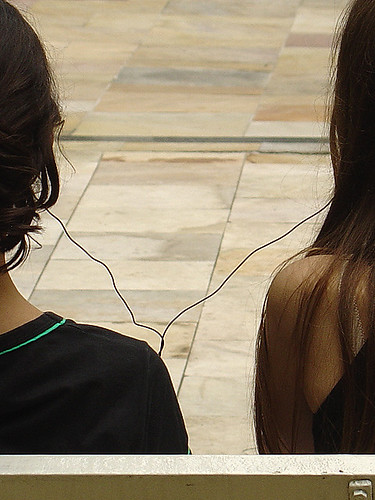During yesterday’s CoETaIL class, we discussed copyright, Fair Use and Creative Commons. We had some great conversations about what copyright really is and what kinds of work (turns out all kinds!) educators can use in preparation of lessons and curriculum. Plus, I was so excited to see one of the members of my PLN, Kristen Hokanson, featured in one of the video case studies we watched (I think that was the first time I’ve heard Kristen’s voice, actually).
 In discussing copyright with my colleagues, and thinking about the future of “ownership” of ideas, I’m thinking that we’re going to see already seeing society value free sharing over the legalities of restricted ownership. Much the way teachers and librarians panicked about the free authorship of wikipedia and the way record companies are floundering about the electronic distribution of music, the benefits of freely sharing ideas will certainly outweigh any attempts to retain the traditional, heirarchical structure of copyright.
In discussing copyright with my colleagues, and thinking about the future of “ownership” of ideas, I’m thinking that we’re going to see already seeing society value free sharing over the legalities of restricted ownership. Much the way teachers and librarians panicked about the free authorship of wikipedia and the way record companies are floundering about the electronic distribution of music, the benefits of freely sharing ideas will certainly outweigh any attempts to retain the traditional, heirarchical structure of copyright.
The same way the iPod and iTunes eclipsed the record industry’s long established system for the distribution of music, Creative Commons (and others freely sharing their works) will eclipse the machinery of the old industries. Already it seems that only those who benefit from the retention of restrictive copyright laws are interested in perpetuating this outdated system.
Even if, as a society, we decided to re-think copyright laws, I don’t know if it’s even necessary. It’s so clear that the culture of remixing, mashups, and selecting to share, will cause a paradigm shift that will soon overshadow any attempts to retain such rigid structures. After all, we only need to examine the way the younger generation views copyright (ask them, they’ll tell you!). Soon enough, they’ll be the ones “in charge.”
There was a time when non-priests were not allowed to read the Bible, and then innovations, like the printing press, put formerly restricted knowledge into the hands of the “masses.” Society didn’t decide as a whole that this was acceptable or preferred, it just happened.
 As educators, we need to be aware of the way these types of societal trends may shape or change the way we use, access and create information and ideas. For me, I prefer to expose students to Creative Commons as an empowering example of how we can all be part of a shared vision for the future, how we can all benefit from the expertise and creativity of others, and how we can truly support and value independent thinkers and artists.
As educators, we need to be aware of the way these types of societal trends may shape or change the way we use, access and create information and ideas. For me, I prefer to expose students to Creative Commons as an empowering example of how we can all be part of a shared vision for the future, how we can all benefit from the expertise and creativity of others, and how we can truly support and value independent thinkers and artists.
I am also committed to discussing and understanding with students the ease with which technology allows us to “borrow” someone else’s work – and how important it is to give credit to the original work. One of my wonderful colleagues, Susi, explained in our small-group discussion that our idea of right and wrong is firmly developed by age 7 (further reinforcing my belief that lower elementary is the place to start having these conversations).
We need to be modeling attribution, and talking about what “stealing” looks like online, and how easy it is to give proper attribution so that students truly understand why it is so important. It can be difficult for students to understand that attribution of an idea to someone else makes your work even more powerful – you’re demonstrating you’ve done your research, you’re building on anothers’ idea and you’re able to combine the experience and expertise of others into your own original thoughts.
Interestingly, after taking another look at ISB’s Elementary School Acceptable Use Policy, copyright is only specifically addressed in relation to software (ie: no pirated software allowed – a major problem here in Thailand). I wonder why we aren’t specifically outlining expectations for using information or creative works?
What do you think of copyright?
stolenmoments by renedepaula
Moveable Type Gallery by Xosé Castro





I am an elementary school librarian and our district curriculum requires that we start teaching about copyright at the same time we start teaching research skills – in kindergarten. At the elementary level, each grade is required to complete 1-2 inquiry process projects, of which citing sources is a component. The youngest students only need to write down the title of the book or websites they used (or even watch the teacher do so…as they get older, we add more components to the bibliography), but we always have the conversation about how plagiarism is “lying, cheating and stealing all rolled into one.” It is a very powerful message because the ideas of right and wrong are so black and white to them at that age!
I agree that we should be moving to a less restrict place of sharing cultural and academic works, and this has been core to my teaching and presentations. Educators need to understand copyright, copyleft/wrong, and public domain materials, what they are, and how to license work under CC licenses. Additionally, the particular rights of CC licenses such as CC/ATT/NC should be discussed. For instance, if we are to promote attribution, make it explicit through an ATT CC license. CC is not perfect, but it is the best that we currently have to promote a free exchange of materials and still instilling the mechanisms that will assist in attribution; one of the key mechanisms for the flow of creative thought in many cultures.
I would also highly recommend you watching this open source film in its entirety – RiP: A Remix Manifesto – http://www3.nfb.ca/webextension/rip-a-remix-manifesto/
Hey Kim…
Saw your tweets the other day about watching the Fair Use video–how fun! I wanted to pass along a few more resources. One is a wiki we developed surrounding the release of the Best Practices statement. On that page, there is a good form for reasoning through the fair use process The purpose of Copyright in the US constitution is to promote creativity, innovation and the spread of knowledge and after watching the video above, I am even MORE convinced that it is not about whether something is copyrighted or not, but more teaching kids to think about WHY they are choosing to use what they are using that is important.
ANYWAY…check out the wiki…there is lots of good stuff there…and TONS of curriculum for teaching kids to think critically about media on the Media Education Lab site. PLEASE pass along to your group, and hopefully we WILL get a chance to meet face to face someday!
@Liz,
I love the way you describe plagiarism to your students! I’m so impressed that you start at kindergarten – I’m definitely going to pass this on to our primary teachers. Often times, it can be difficult to agree on what is developmentally appropriate for younger grades, and your successful examples will be a perfect starting point for us.
@Alec,
Thanks for the link – I’ll also share it with the rest of our CoETaIL class as well. In fact, we should have watched your K12Online presentation on Saturday’s lesson – it would have been perfect!
@Kristin,
Thanks so much for all the resources! I have to admit that I was surprised to learn that copyright was/is intended to promote creativity and innovation – that’s certainly not the understanding I had about copyright before we started the course. Now I feel that’s what Creative Commons does so well – and in essence they’re just giving us more explicit control over our own copyright structure.
I totally agree about teaching students to thinking about why they are choosing particular media. One topic that keeps coming up in these courses is the fear that we are simply asking students to post and repost and regurgitate ideas in different ways – instead of developing tasks that encourage creativity and original thought, through the use of technology. This is something I think we need to be especially conscious of, especially when learning about Fair Use, because it’s really not about how much we can use, but what we should use and why.
As much as we talk about copyright with our students, they still don’t get it. I was called up to a classroom several weeks ago because a class was having problems with a dvd player. When I got there, the teacher was going to show a bootleg copy of a movie one of the students brought in. The teacher didn’t know it was a bootleg copy or that she shouldn’t even show it. The kids all knew it was, but didn’t care one bit. The movie was still in theaters! I said they couldn’t watch it, and they were fine with that. It’s an uphill battle if some teachers are still unaware of what’s right and wrong and if students don’t care.
I always get so much from your posts! I have been struggling with copyright lately on a project so your views, Info, tips and comments are timely. I will share with my library media colleagues. Thanks, again!
@Chad,
Oh boy. Well, I guess this is the perfect example of why copyright and Fair Use needs to be a part of our curriculum. Sometimes I think we’re all guilty of ignoring the “rules” in favor of “getting things done” and the more we are aware of how severe the consequences can be, the less we will do it. I also think it’s so important to be good role models for our students. The more we let ourselves take advantage of Fair Use (without explaining to students that’s what we’re doing), the more they see stealing as “fair.” It’s a slippery slope, isn’t it?
@Janelle,
Thank you! I’m so glad the posts are helpful!